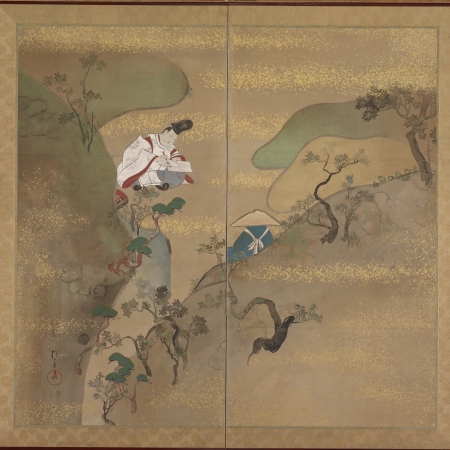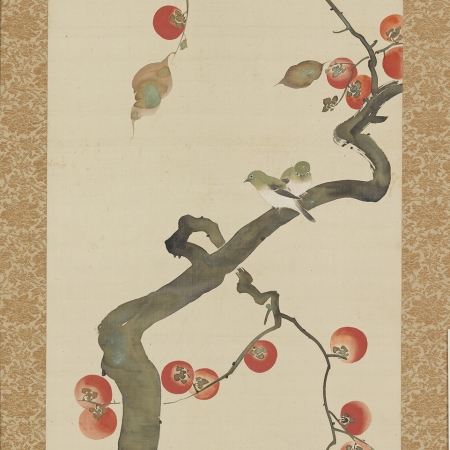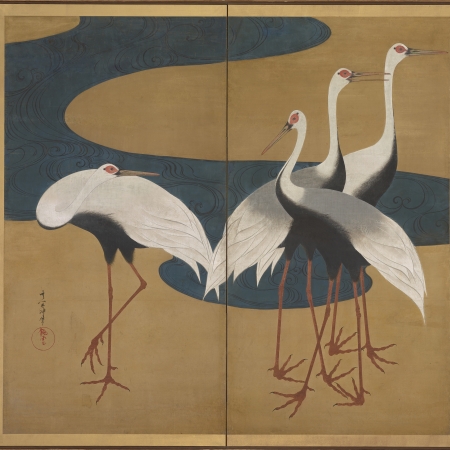GALLERY 2600 | EAST ASIAN ART
 The Rinpa School was less a formal school than a group of artists connected across time by a common aesthetic vision and shared painting techniques. Rinpa’s roots can be traced to the Kyoto-based artists Tawaraya Sōtatsu (d. 1640) and Hon’ami Kōetsu (1558–1637). Their arresting and elegant approaches to established literary and seasonal motifs across a variety of media garnered the patronage of courtiers and wealthy merchants residing in the imperial capital. Later revived by Ogata Kōrin (1658–1716), from whom the name of the school is derived (Rinpa means “School of Kōrin”), the Rinpa aesthetic would come to be defined by a simplification and stylization of natural forms, bold expanses of intensely colored pigments, and an extravagant use of ink. The tarashikomi (literally, “dipping in”) technique in particular became a hallmark of Rinpa painting. Used in many of the works in this gallery, tarashikomi involves applying multiple layers of ink on top of each other before the previous layer has fully dried, allowing the wet pigments to pool in apparently artless and unpredictable ways. Self-styled followers of the earlier masters, Rinpa artists studied their predecessors’ paintings circulating in private collections and in printed books. It was during the early 19th century that the artist Sakai Hōitsu (1761–1828) made efforts to define and codify the Kōrin style and artistic lineage, thus effectively creating the Rinpa School. The aesthetic continued into the 20th century, when painter and designer Kamisaka Sekka (1866–1942) infused Rinpa subjects with modern design sensibilities. The paintings in this gallery come from the extraordinary collection of Robert S. and Betsy G. Feinberg. Remarkable for the quality and range of its Edo period (1615–1868) paintings in particular, the Feinberg Collection has been generously promised to the Harvard Art Museums.
The Rinpa School was less a formal school than a group of artists connected across time by a common aesthetic vision and shared painting techniques. Rinpa’s roots can be traced to the Kyoto-based artists Tawaraya Sōtatsu (d. 1640) and Hon’ami Kōetsu (1558–1637). Their arresting and elegant approaches to established literary and seasonal motifs across a variety of media garnered the patronage of courtiers and wealthy merchants residing in the imperial capital. Later revived by Ogata Kōrin (1658–1716), from whom the name of the school is derived (Rinpa means “School of Kōrin”), the Rinpa aesthetic would come to be defined by a simplification and stylization of natural forms, bold expanses of intensely colored pigments, and an extravagant use of ink. The tarashikomi (literally, “dipping in”) technique in particular became a hallmark of Rinpa painting. Used in many of the works in this gallery, tarashikomi involves applying multiple layers of ink on top of each other before the previous layer has fully dried, allowing the wet pigments to pool in apparently artless and unpredictable ways. Self-styled followers of the earlier masters, Rinpa artists studied their predecessors’ paintings circulating in private collections and in printed books. It was during the early 19th century that the artist Sakai Hōitsu (1761–1828) made efforts to define and codify the Kōrin style and artistic lineage, thus effectively creating the Rinpa School. The aesthetic continued into the 20th century, when painter and designer Kamisaka Sekka (1866–1942) infused Rinpa subjects with modern design sensibilities. The paintings in this gallery come from the extraordinary collection of Robert S. and Betsy G. Feinberg. Remarkable for the quality and range of its Edo period (1615–1868) paintings in particular, the Feinberg Collection has been generously promised to the Harvard Art Museums.
December 3, 2015–June 7, 2016




